How to maintain chicken equipment
Chicken farming equipment is a unique mechanical equipment used in chicken farms to produce chickens, breeders, broiler chickens and laying hens. Today will introduce in detail how to maintain chicken equipment. Only by taking good care of your own stacked chicken battery cage equipment can you use it for a longer time and exert greater value.
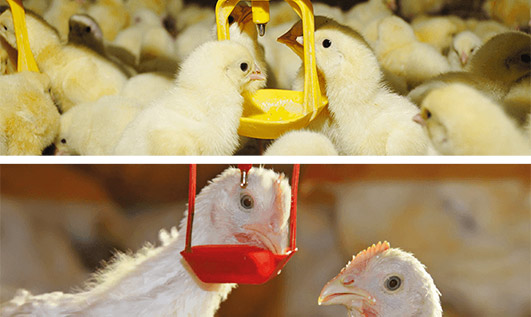
1. The chick method of heating equipment exhaust duct is more suitable for large, medium and small chicken farms. Exhaust ducts should be constructed with bricks or adobe bricks. Large and medium-sized chick rooms can use long flue exhaust ducts, while smaller chick rooms can be used in the field to tightly surround the flue exhaust duct. When designing the exhaust duct, the diameter of the exhaust duct should be large, and the duct at the inlet and outlet of the soot should be gradually reduced to facilitate heating and the circulation system of the exhaust system to prevent the soot from flowing back.
2. Tower-free water supply equipment can use hanging tower type Fully automatic drinking water equipment breeding equipment. This type of drinking water equipment is hung from the suspended ceiling based on a rope and a camisole. The top water inlet pipe is connected with the main water pipe according to the plastic hose, and the seepage water is injected into the drinking water tray according to the pressure regulating valve, which is environmentally sanitary and saves water.
3. The breeding equipment is mainly the selected trough, and the long-pass trough is used for cage breeding.
4. Fluorescent lamps are commonly used as lighting fixtures at this stage. Many chicken farms install timers to automatically control the power switch of the system lights, instead of manual power switch lights to ensure the accuracy and reliable characteristics of the lighting fixtures. It can also be lit by fluorescent lights, which face the suspended ceiling, and reflect the light source to the road surface according to the suspended ceiling. The diffused light is gentle and symmetrical.
5. Egg laying machinery and equipment: Two-layer egg boxes can be used to feed broiler breeders or laying hens. In addition to feeding on a plan view, chickens are generally fed in overlapping or stepped iron cages. Most of the laying hens are kept in iron cages. Carrying out cage breeding and cage breeding can make flexible use of indoor space, increase breeding volume, help epidemic prevention, and save concentrated feed. A small feeding cage can set a curtain cloth at one end of the cage to block the chicks.
The characteristics and types of chicken cage
Generally, layer cages can be divided into full ladder cages, half ladder cages, stacked cages, ladder mixed cages and flat cages according to the cage shape or assembly method.
Full-step layer cage, the upper base layer cage does not overlap in the vertical direction, so that the feces of each layer can fall into the lowest ditch, and then the ground scraper installed in the ditch will remove Manure is cleared out of the chicken cage.
Half-step layer cage, the upper and lower cages are somewhat stacked, and the stacking amount can reach 1/2 to 1/3 of the depth of the cage. The top net of the base-level cage is made of oblique angles to facilitate the installation of the manure bearing plate, so that the manure accumulated in the upper layer will fall into the manure ditch under the cage under the action of gravity after air-drying. This method is often used in breeding chicken cages and breeder cages produced in China. The half-step chicken cage occupies a small area, and the housing density is higher than that of the full-step chicken cage.

Poultry battery cages for sale, each layer of battery cages in the vertical direction, and there is a horizontal manure bearing device under the bottom net of each layer of cages. Scraper manure cleaners or conveyor belt manure cleaners can be used to deliver chicken manure to each row of chickens At one end of the cage, the chicken manure is sent to the outside of the house by the horizontal spiral manure scraper, and the small overlapping chicken cage can manually clean the manure. Feeding, drinking water, cleaning manure, and egg collection are all easily mechanized. The advantage of overlapping cages is that the housing density is high, generally 16-18 birds/m3 for three layers, and 18-20 birds/m3 for four layers, which makes the civil investment of each chicken low and high labor productivity; the disadvantages are each The vertical ventilation between the layers is poor, and the environmental conditions of each layer of the chicken cage are quite different, which requires high environmental control of the chicken house.
Step-stack hybrid layer chicken cages, the upper and lower layers are staggered, the middle and lower layers are all overlapped, and the top net of the lower layer is equipped with a manure bearing plate. The manure can be manually pushed inward to make the manure fall or Use a mechanical scraper to remove it.
The horizontal layer cage has only one layer of cages, and every two rows of cages are installed back to back. A feeding trough, a water trough and an egg belt are used together. The manure can be directly dropped to the ground. Drinking and manure removal equipment and ladder cages the same. The horizontal chicken coop does not need to be equipped with a corridor, so the feeding density of the house is higher than that of the full ladder type, but the feeding, drinking, manure removal and eggs must all be mechanized. Therefore, the mechanical equipment used must be reliable and highly dependent on electricity. Once power is cut off ,The consequences could be disastrous.
Problems to be overcome in using broiler cage equipment to raise chickens
The use of broiler chicken cage equipment is the development trend of broiler breeding. More and more chicken farmers have begun to try to adopt the mode of broiler cage breeding, which is currently one of the advanced production methods in the broiler breeding industry. It has the advantages of saving land resources, improving breeding conditions, improving production performance, and reducing disease incidence. However, in order to achieve greater economic benefits, it is necessary to overcome its existing problems and maximize the benefits of broiler cages.
The main technical characteristics of broiler cages are as follows: First, the three-layer overlapping cage technology is adopted. The second is to be equipped with an automatic manure removal conveyor belt to clean manure in time and reduce harmful gases such as ammonia and sulfur dioxide in the house. The third is that the entire cage is made of hot-dip galvanized metal anticorrosive materials, and the bottom of the cage is covered with wear-resistant and corrosion-resistant plastic nets, which can effectively reduce the incidence of breast cysts and leg diseases in broilers. Fourth, the chicken house is fully enclosed, relying on air intakes and exhaust fans on both sides of the house to maintain air quality in the house. The staggered installation of incandescent lamps reasonably realizes artificial lighting, and the use of water heaters, wet curtains, and automatic spray devices to achieve temperature and humidity control in the house.
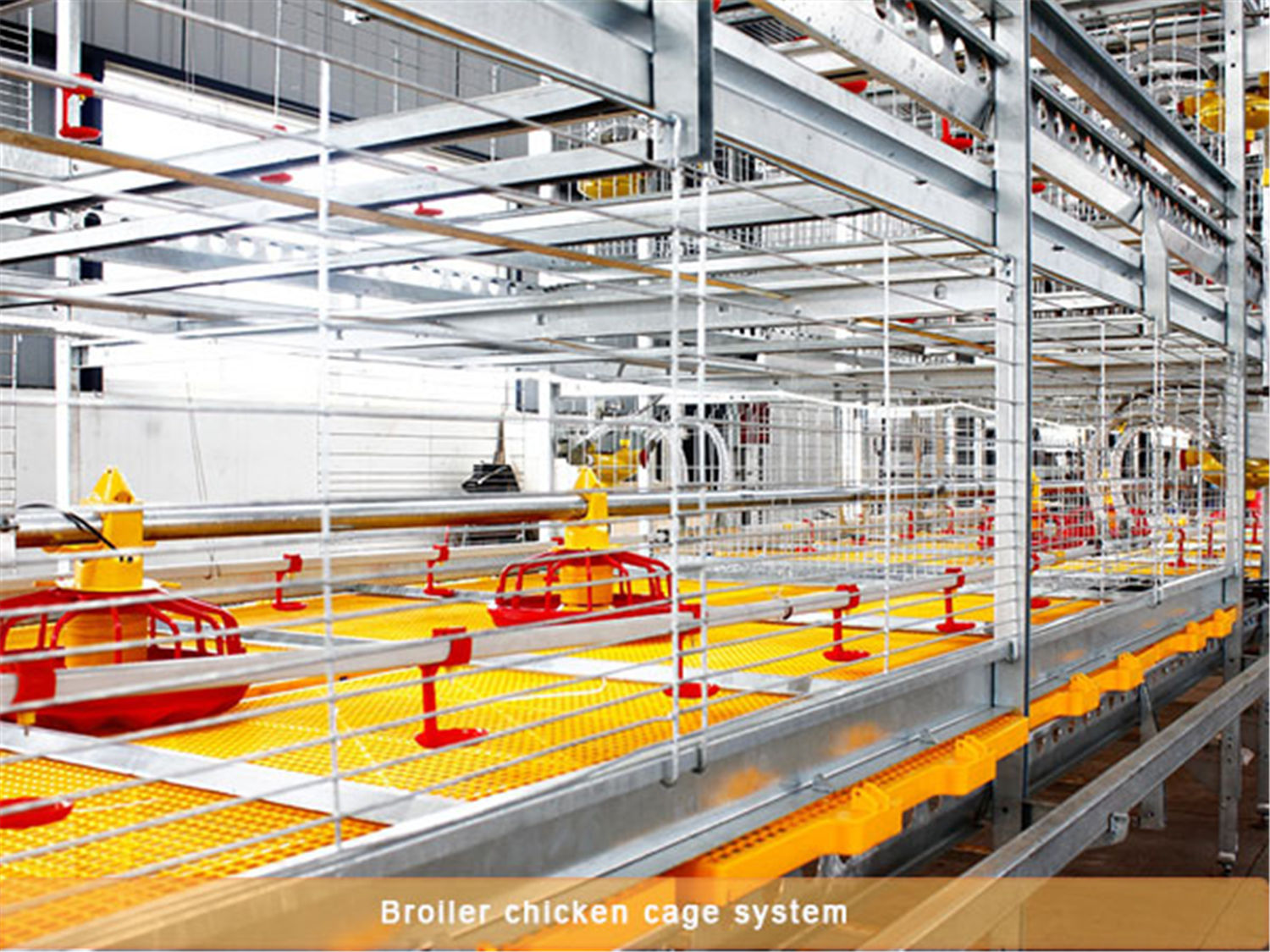
Experiments show that the technical advantages of commercial broiler cages over online breeding are very significant. Not only can increase the number of breeding, improve production performance, save production costs, and bring significant economic benefits to farmers. It can also save land resources, reduce environmental pollution, improve product quality, and create huge social benefits. In line with the development requirements of "scale, standardization, industrialization, and ecologicalization" of the broiler breeding industry, the widespread promotion and application will help accelerate the process of standardization and transformation of livestock and poultry farms, and effectively promote the upgrading of the livestock industry.
Although cage breeding has significant technical advantages over online breeding, there are still some problems with cage breeding technology, mainly in the following three aspects. One is that the initial investment of cage culture is larger than that of online culture, but because the profit rate of cage culture is much higher than that of online culture, the return is quick. Second, the technical requirements of cage breeding are higher than that of online breeding. Because cage houses are closed and fully automated, technicians must not only master breeding management techniques, but also be familiar with the operation of modern equipment. Third, the ventilation requirements of cage breeding are higher than that of online breeding. Because cage breeding is multi-layer breeding, it is more dense than online breeding, which easily causes poor air circulation in the house. Therefore, the above three points are the problems that farmers who use broiler farming cage equipment to overcome.
Feeding and management methods of caged broilers in summer
1. Temperature management
The optimum temperature for adult chickens: between 18-23 degrees Celsius, high temperature is likely to cause heat stress. Especially the chicken in the chicken battery cage, Watch the chicken temperature: pay attention to the humidity of the chicken house. Use somatosensory temperature during the day to find ways to cool down so that the chickens reach a comfortable somatosensory temperature; use the indicated temperature at night.
2. High temperature and heat stress
The temperature exceeds 28 degrees Celsius and begins to pant. If the temperature exceeds 30 degrees Celsius, breathe out. Feed intake decreases and drinking water increases. Chicken flocks with temperature above 32 degrees Celsius suffer from paralysis, hypoxia, rapid increase in respiratory rate, snoring, and groping.
3. Control measures for heat stress:
Use cooling equipment: fan + wet curtain, first turn on the fan that can be used, and use the wind speed to reach the appropriate body temperature to produce the air cooling effect. Secondly, use wet curtains: the temperature exceeds 30 degrees Celsius, and the humidity is lower than 75%; use gradually, ranging from small to large; first use the side walls, and finally use the gable wet curtain. Finally, install a wind screen in the chicken house to reduce the cross- sectional area of the chicken house and increase the wind speed.

4. The density is not divided into groups
The density of flocks in summer should be reduced, and it is advisable to have 24-25 birds in 3 layers in each group. The flocks should be kept at a reasonable density and grouped as soon as possible. The first grouping should be 8-13 days old, and the second grouping should be 21-22 days old. Grouping in summer should be in the morning or evening to reduce heat stress in the flock.
5. Feeding management
Feed feeding: Adjust the feeding time and change to a cooler time. Avoid high temperature periods in the morning or evening. Don't concentrate on feeding before 6 pm; pay attention to moldy feed to prevent poisoning or intestinal diseases. Slot and limit light once.Keep clean for automatic chicken drinkers and feeders
6. Drinking water management
Provide fresh and clean drinking water to ensure sufficient water. Protect intestinal health. Water quality standard: total bacteria count standard: less than 100 per milliliter; E. coli group should be 0 per milliliter, and the maximum should not exceed 50. The water line should be cleaned regularly. During the feeding period, the height of the waterline is adjusted every two days according to the age of the flock, so that the chickens can lift their heads to pass the waterline. Check the waterline nipple every day to see if there is any water, and replace the waterline nipple that is out of water or leaking water in time to avoid the occurrence of diseases due to lack of water in the flock.
7, the management of chicken out of slaughter
When the outside temperature is higher than 26 degrees Celsius, the chickens are released. After the chicken cage is loaded, the water must be pumped to cool down in time. When the water is pumped, the water must be drained. While waiting for the slaughter in the slaughterhouse, the chickens must be pumped to ventilate and cool in time to prevent thermal stress of the chickens. Excited death.
What equipment should be included in professional chicken breeding equipment?
Chicken farming equipment includes heating equipment, ventilation equipment, water supply equipment, feeding equipment, egg collection equipment, manure cleaning equipment, cages, lighting equipment, etc. In addition to the above, do you know what other equipment is needed? Today we will take you to understand:
1. Disinfection equipment: agricultural sprayers, air pumps, etc.
2. Immunization and treatment equipment: continuous syringes, needles, etc.

3. Beak cutting equipment: electric beak breaker, electric soldering iron, etc.
4. Weighing equipment: spring scale, steelyard, electronic scale, etc.
Creating a modern chicken farm requires not only modern poultry breeding equipment, but also modern breeding concepts. Modern breeding concepts include: establishing awareness of good breeds, brooding of youngsters is equally important, paying attention to usual management, strengthening disinfection, paying attention to feed quality and using less drugs, etc. If you have any other questions, please consult us.
What do you need to prepare for chicken cage
As the market demand for eggs and chicken continues to increase, many users want to join the army of raising chickens in order to improve their own benefits. For novice farmers, they must learn and prepare everything they need before raising chickens. In terms of what needs to be prepared to raise chickens, we have summarized a few key points for farmers, and now we will share them with you novice farmers.
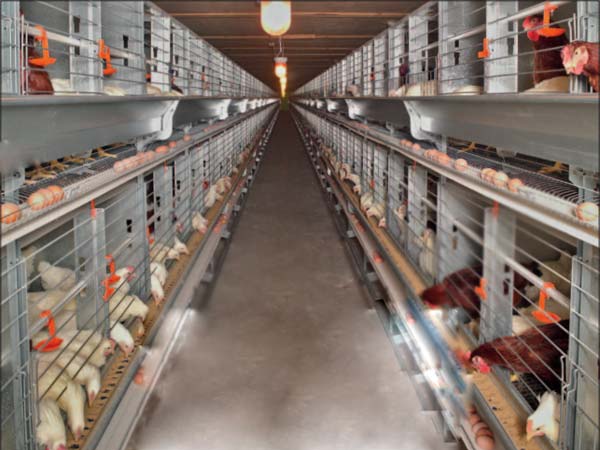
1. Choose the right chicken raising equipment: nowadays, chicken raising is no longer a fully artificial era. Whether it is a small chicken house or a large chicken house, some chicken raising equipment must be used to assist chicken raising and improve the efficiency of chicken raising Among them, chicken battery cage are the chicken-raising method chosen by most farmers. The multi-layer cages used in chicken cages can increase the utilization rate of the chicken house and increase the number of chickens. In addition, there are poultry feeding equipment, manure cleaners, and egg pickers. Chicken farming equipment such as fan and wet curtain are commonly used by modern farmers. Farmers can choose some chicken farming equipment reasonably according to their actual conditions for auxiliary breeding.
2. Adjust the temperature before entering the chickens: chickens are generally raised from chicks, which are newly born chickens, and all functions of the body have not grown well, so a relatively high temperature is required to adapt to the environment and grow healthy. Therefore, before letting the chicks enter the chicken house, the breeder should adjust the temperature of the chicken house in advance, and adjust the temperature of the chicken house to above 28℃, and then gradually reduce the temperature as the chicks grow.
3. Disinfect before entering the chickens: most of the chicken houses of novice farmers are new, and many farmers think that disinfection is not necessary. In fact, it is not the case. Whether it is a new or an old one, you must be careful before entering the chicken. In this way, the hygiene and health of the chicken house can be ensured. It is recommended that the farmers thoroughly disinfect the chicken house within one week before entering the chicken.
4. Check whether the utensils are complete: chickens need a lot of utensils, such as feeders, sinks, drinking fountains, lighting equipment, thermometers, hygrometers, syringes and other utensils. These utensils must be prepared before raising chickens, so that they can be used. Don't panic during the process of raising chickens, you can find what equipment you need in time, it is unnecessary to buy, and time is wasted.
5. Purchase good vaccines and immunization equipment: In the process of raising chickens, in order to prevent various infectious diseases of the chickens, the farmers need to immunize the chickens in time, so before raising the chickens, the farmers must learn first What kind of immunization is needed at the chick stage, and then choose a good vaccine and immunization equipment.
6. Vehicle preparation: Farmers must first determine how many chicks they need to raise before entering the chickens. After determining the transportation quantity, choose different vehicles. Generally, vans are used for transportation within 2000.
Characteristics and dimensions of three tiers of broiler cages
In the past, farmers raised broilers in flat greenhouses, and the number of breeding was small. It has been difficult to meet the market demand for chicken product quality. Moreover, the simple raising equipment may cause the disease to be difficult to control, which will inevitably affect the meat output of broilers. However, the broiler cage raising equipment vigorously promoted by the breeding industry can implement automatic fecal removal, so that the broiler is separated from the fecal sewage, achieving less incidence, fast growth, good quality and good benefits. Now the author will talk about the characteristics and dimensions of broiler cages.
Characteristics of broiler cages:
1. The stacked broiler cages produced by high-quality poultry equipment suppliers use a full set of hot-dip galvanizing technology, which is corrosion-resistant and has a service life of more than 20 years.
2. The material of Q235 has great elasticity and is not easy to bend.
3. The high-density breeding saves land, which is about 70% less than the stepped land.
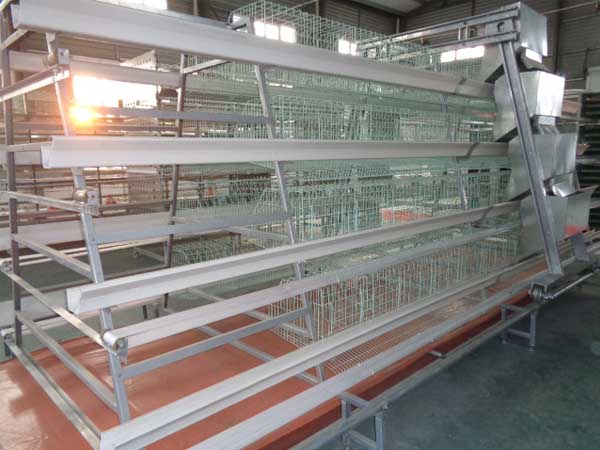
4. Centralized management, save energy and resources, adopt advanced ventilation system, lighting system and automatic control system to fully save energy consumption and improve labor productivity.
5. Save space and increase the feeding density to more than 60 animals/m2.
6. The unique cage door design effectively prevents the chicken from shaking its head up and down when it is eating.
7. The use of conveyor belt to clean the manure to dry the chicken manure into granules, reduce environmental pollution, and high reuse rate of chicken manure.
8. Eco-environmental protection is the most ideal feeding equipment for green chicken and environmental protection egg products.
Broiler cage size:
The cascading broiler cages have three layers and two doors. Each group has a length of 140cm, each group spans 200cm, the number of units is 6, the unit length is 70cm, the unit depth is 70cm, the cage height is 38cm, and the feeding amount is 60.
Stacked broiler cages with four layers and two doors, each group length 140cm, each group span 200cm, unit number 8, unit number 70cm, unit depth 70cm, cage height 38cm, feeding capacity 80.
Each poultry farming equipment supplier provides different sizes of chicken cages, so when buying, you only need to buy according to your own needs, and you don't need to be constrained by the size of the chicken cage.
Temperature and humidity control of breeding equipment chick house
(1) Suitable temperature for laying chickens in laying hen breeding equipment: brooding temperature of egg chicks: 35-33°C for 1-2 days, 33-32°C for 3-7 days, then decrease by 2 to 3°C every week, From 5 to 6 weeks old, about 21 to 18 ℃. Whether the supplied temperature is appropriate, in addition to the thermometer, the behavior of the chicks should also be observed. Chicks are more sensitive to cold and warm, so pay special attention to prevent the temperature from rising and falling, and make every effort to maintain a balanced temperature. When mastering the temperature, the temperature will be higher at night or in rainy or snowy days; during the day, the chicks will be active and the weather will be warmer, and the temperature should be lower; the weak chicks should be higher, and the healthy chicks can be lower.
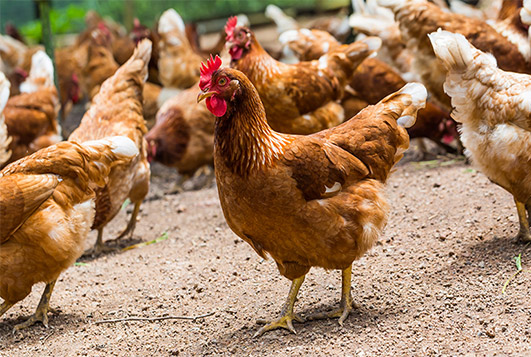
(2) Humidity suitable for laying chickens in layer breeding equipment: Humidity is closely related to water evaporation, body heat emission and cleanliness of the chicken house.
① When the temperature is high and the humidity is low, too much water is lost in the chicken, which may cause the chicks to dehydrate. In addition, due to the dryness caused by the dust in the house, it is easy to induce respiratory diseases.
②When the temperature is low and the humidity is high, the house is cold and humid, and the chicks are prone to catch colds, causing litter to be wet, and gastrointestinal diseases and coccidiosis occur.
③When the temperature is high and the humidity is low, the heat in the chicks is not easy to radiate normally in poultry farming equipment, stuffiness, decreased appetite, slow growth and weakened resistance.
It is better to keep the hen house of laying hen breeding equipment dry to prevent bacterial propagation and infection, but the relative humidity should not be lower than 40%. Appropriate relative humidity: 60% -65% before 10 days old, 50%-60% after 10 days old. When the humidity is insufficient, you can sprinkle water on the corridor, floor, surrounding walls or flue in the house, or you can put a water basin on the heat source to evaporate water vapor to increase the humidity in the house; when the humidity is too high, you can lay a moisture-proof layer on the floor of the chicken house , Appropriately raise the temperature in the chicken house, strengthen ventilation and ventilation, change the litter in the chicken house, remove the wet feces and litter in the house in time, and prevent the drinking fountain from leaking.
Humidity conditions for laying chickens in laying hen cages
When using layer chicken cages to raise chickens, humidity is also an important condition for brooding, but chicken farmers generally do not pay enough attention. The humidity in the brooding house is generally expressed in relative humidity. The higher the relative humidity, the more humid the air; the lower the relative humidity, the drier the air.
After the chicks come out of the shell, they enter the brooder house. If the humidity of the air is too low, the moisture in the chicks will be exhaled through breathing, which is not conducive to the absorption of the remaining yolk in the chicks and the growth of the chicks' feathers. Once the chicks have been given a drink, the chicks often develop diarrhea due to too much water.
Appropriate humidity requirement: 60%-65% before 10 days of age, and then reduced to 55%-60%. In the early stage of brooding, due to the dry litter, the house is often hot and low humidity, which is easy to increase the water loss of the chicks, loss of appetite, frequent drinking, dry and brittle fluff, and dry toes.

In addition, too dry can easily lead to dust, causing respiratory and digestive diseases. Therefore, this stage must pay attention to the replenishment of water in the house. You can spray water on the aisle or wall of the house to increase humidity, or place a basin or kettle on the stove to burn water to generate steam to increase the humidity in the house.
After 10 days of age, the chicks developed quickly, gained weight, and their feed intake, water intake, breathing volume, and excretion volume increased with each passing day, and the temperature in the house gradually decreased. Especially in the midsummer and rainy seasons, it is easy to have excessive humidity. The chicks are not well adapted to the humid environment. The low temperature and high humidity in the brooding house will exacerbate the adverse effects on the chicks at low temperatures. The chicks will feel colder and even tremble with cold, at this time susceptible to various respiratory diseases. When the high temperature and high humidity in the brooding house, the water evaporation and heat dissipation of the chicks are hindered, and they feel more sultry and uncomfortable, and the chicks are prone to coccidiosis and aspergillosis.
Therefore, during the period when laying hens cages are used to raise chickens, it is necessary to change the litter frequently and strengthen ventilation. When adding drinking water, prevent water from spilling onto the ground or litter.
Feeding "Four Attentions" in Laying Hens
In the process of laying chickens in laying hen cages, in order to give better performance to laying hens, in addition to paying attention to daily feeding management, the feeding work is also very important. Whether the nutrition of the feed is balanced is to protect the eggs The key to achieving nutritional standards in chickens, so feeding farmers can’t ignore them. Let’s talk about the four precautions for feeding chickens in several laying hen cages. I hope that farmers can avoid misunderstandings and feed reasonably. Layer chicken flock.
1. Don't feed chicken with raw bean cake: protein is a necessary nutrient for laying hens, and bean cake farmers know that it is a good protein nutrition raw material, but raw bean cake contains anti-trypsin, hemagglutinin and other substances. Feeding chicken directly with it will not only reduce the utilization rate of soybean cake, but also hinder the growth and development of chicks and affect the egg production of chickens. The correct way is to cook the raw bean cake to destroy the harmful substances. In this way, the chicken can grow fast and lay more eggs.
2. Don’t overfeed fish meal with fish: animal feed is also a nutrient raw material often added by farmers. Fish meal is an animal raw material rich in high protein and is a necessary substance in feed, but if the farmer gives chickens Feeding more fish meal not only increases the cost, but also makes chickens sick with vomiting. Therefore, when using fishmeal to prepare feed, the dosage must be controlled below 10%, and the chickens must be carefully observed. Once vomiting disease is found, the fishmeal dosage should be adjusted in time.

3. Don't feed chickens if the eggshells are not sterilized: the formation of eggshells requires a lot of calcium, so calcium is an indispensable nutrient in the production of laying hens. Similarly, eggshells are also a good calcium- based feed for feeding eggs The shell is easy to absorb, improves egg production rate, and has a good effect on the prevention and treatment of rickets and soft egg production. Therefore, it is very popular with farmers. Most farmers will feed eggs and eggshells for calcium supplementation, but farmers should pay attention to eggshells that are easy to deteriorate and not easy to store for a long time. Therefore, the eggshell must be dried, sterilized and stored properly to receive good results.
4. Don't feed raw grains to chickens: Many farmers choose to use raw grains for feeding to laying hens and chickens, but this is wrong. If farmers use raw grains to feed chickens, they will waste food. It can't get good benefits, because chickens have no teeth, the digestive tract is short, and the raw grain is difficult to digest, which can't meet the nutritional needs of the chicken. Chicken feeding is much better.
The above is the four "don't" feeding chickens in the process of laying hens in Poultry Equipment for Sale. I hope that farmers can pay attention to the above wrong feeding methods after learning these contents, and scientifically and rationally feed laying hens to improve The economic benefits of farmers.
